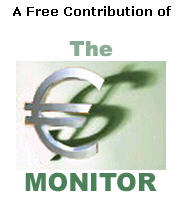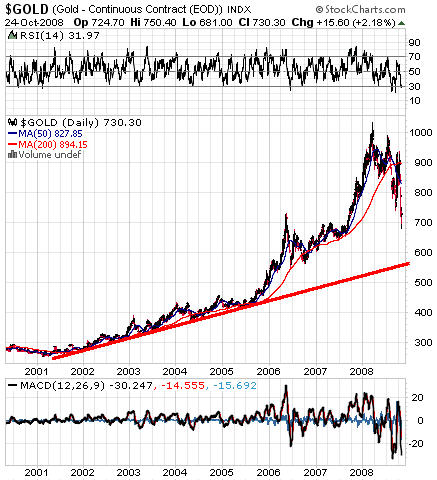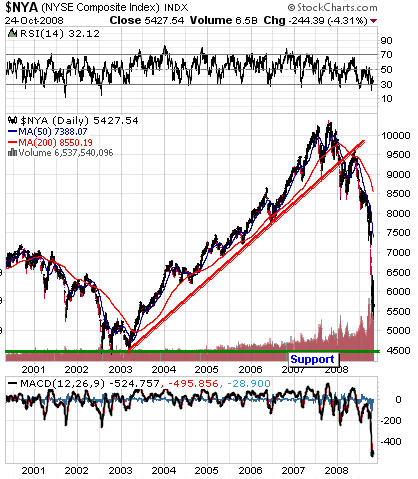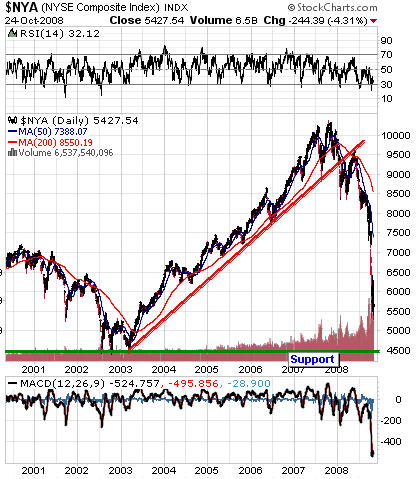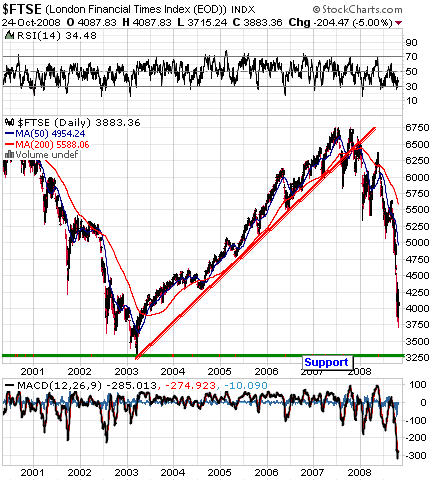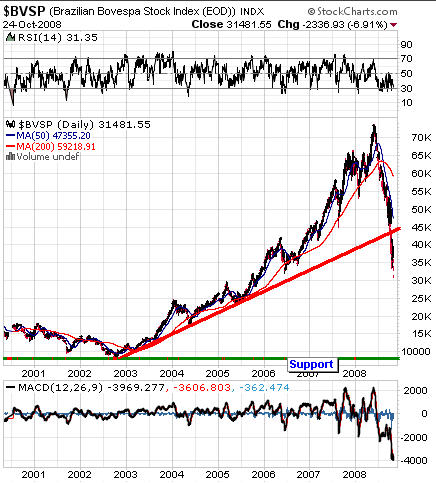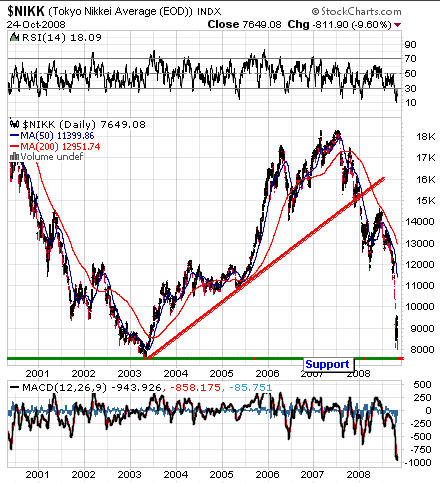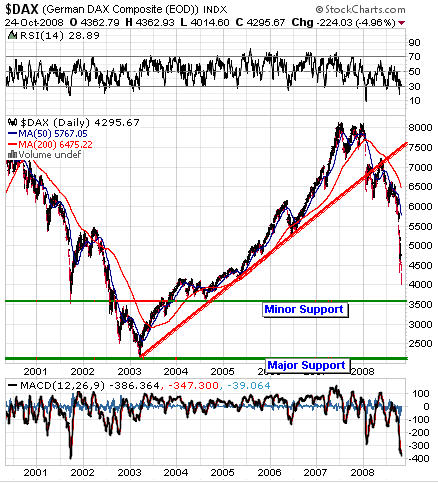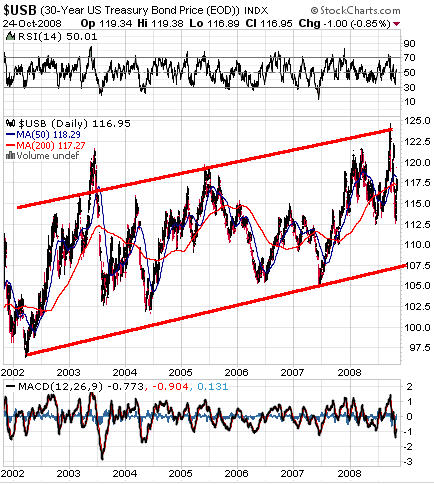|
When Gold Will BottomIn short, gold will bottom when stocks bottom and the dollar bounce falters - unless fund managers run out of gold to sell before either of the other two events occur (or unless global investors suddenly come to their senses. Good luck on that one!) In times like these, anyone would be crazy to predict an actual time when COMEX gold will reverse itself and start rising again, and you’d be crazy to believe it if someone did. At this point, nobody can say it will be tomorrow, or next week, or whatever. On the other hand, it is indeed possible to offer some common sense, bedrock parameters that will tell you that the bottom is in for our favorite derivative to start coming back from the road kill category. But, first let’s put things in perspective. Let’s compare the performance of COMEX gold (we’ll call it “c-gold” for brevity’s sake) during the last ten years with the performance of the major US stock markets, and then with US government debt. Here is c-gold in USD:
And here are a number of major stock markets:
You get the idea. The only major asset that has maintained any kind of uptrend since 2000 is comprised of longer term US Treasuries, albeit with super-wide, horrendously erratic swings. These swings are an indication that treasuries are having their own problems. Here is a shot of the 30-year bond: The long term creditworthiness of the US government is thrown severely into question by its already existing 56 trillion dollar unfunded debt obligations (which have mushroomed under the present 'conservative' president). The roughly $3 trillion thrown at the credit crisis in the past few months don't help there, either. It thus becomes evident that real (not "c") gold is a far better asset to be in than anything stock or bond-related. This is true even if gold’s value is measured by the misbegotten paper-contract price the COMEX and other exchanges provide. So far, so good. We have discussed in previous articles why gold is declining when it shouldn’t. Gold contracts are being sold to keep fund managers’ cash positions at sustainable levels, not because real investors are selling real gold. The proof for that lies in the fact that gold is harder and harder to get at these ever-lower prices. We also all know only too well why stock markets are caving in all over the world. We know that this cave-in is causing the fund managers to sell their PM contracts on the paper exchanges where they bought them, so it would only be logical to expect that the c-gold carnage will stop when the stock market rout comes to its end and stocks bottom out. That is certainly a necessary condition for a powerful rebound in c-gold – but not a sufficient one. The sufficient condition will be satisfied when the dollar’s recent rebound falters and reverses. Why Did the Dollar-Chicken Cross the Road?C-gold is experiencing its most hair-raising recent drops only in dollar-terms because the dollar is currently rising against all other currencies except for the yen. It is rising because the ‘cash’ so many fund managers are selling c-gold for is denominated in dollars, and because the loans that seeded the entire – currently unraveling - economic miracle of the “BRIC” (Brazil, Russia, India, and China) and Pacific rim countries are now being called in by the ailing UK and European banks that made them. If you are a company in emerging country X and you borrow eurodollars in the world markets and then spend them in your country’s economy to build whatever, you end up with earnings in your home currency. When your lender calls in his loan, you need to sell assets or home-currency and buy dollars to pay them back. It’s that simple, and that is what’s happening. It is one big reason for the dollar’s rise from the previously presumed ash heap of history. Why are these UK and EU lenders calling in (i.e., no longer revolving) their loans? Because they themselves are in trouble now, courtesy of the US-induced asset-backed debt instrument meltdown, which served as the foundation of much of the recent pyramiding of financial assets around the world. European and British banks were heavily invested in US ABCP (asset-backed commercial paper) and other collateralized debt obligations. All of this is now unraveling with lightning speed on a global level. I, like many, thought the US collapse would come as a result of the dollar’s eventual collapse. Interestingly and ironically, the US collapse will now come as a result of the dollar’s undue, untimely, and most inconvenient rebound, if that rebound should indeed be sustained. Because of the dollar’s unexpected rebound, the fall in the price of c-gold (traded on a US exchange in New York) is magnified in the US. In many other countries, gold prices are at all time highs (as in India, above 12,000 rupees per gram because the dollar is gaining and they must buy their gold in dollars. This is one of the main reasons why gold buying in India has, until very recently at least, been sluggish despite the ongoing festival season. How About the Euro?Then there is the problem with the euro. The US housing crash has set off a chain reaction in Europe, whose major banks are having a similar problem with Eastern European countries as the British (and European) banks have with the BRIC and Asian rim countries. Untold billions of euros were pumped into the economies of the former USSR satellites – and those are now crashing, a la Reykjavik. They can’t pay the money back, so it simply disappears from the balance sheets of the European lenders, and therefore from the EU economy. Because of the structure of the euro-zone EMU arrangement, the ECB doesn’t have the money-printing and policy-setting monopoly of a US Federal Reserve. Member countries, on the other hand, no longer have sufficient tools available to deal with their own monetary problems, having abdicated much of their power to the ECB. As a result, both institutions (ECB as well as member-country central banks) are stuck in the mud of the US-originated credit crisis. This causes stresses that can easily tear the EU’s monetary union apart. As it falls apart, member countries will have to revive their legacy currencies and will probably be forced to honor obligations they incurred in euros in the form of their revived national currencies. Likewise, ‘euroeuros’ (euro-denominated deposits circulating outside the euro zone) will have to be converted to legacy currencies – but of which country? There is no way of tracking which part of what deposit originated where. That’s the big question – and the big challenge. The only way to effectively deal with this is to create a European version of the US Fed with similarly monopolistic banking regulatory and money-issuing powers. But then what? Will it really help, or will it be too late? If it helps, the euro has a chance to rebound. If it doesn’t, the euro will simply disappear from the world scene, leaving a wake of financial destruction wherever non-EU euro-deposits cannot be converted into resurrected legacy currencies. What a mess! In any case, what is at stake here is the global, debt-based financial system’s very ability re-instill the confidence that people once had in it. Investors worldwide are going to get very, very uncomfortable soon. 'Good' for Dollar Means BAD for the US!As alluded to earlier, the ironic thing is that the rising dollar will do the US economy in for good, if it persists (as if that was necessary in an environment of skyrocketing home foreclosures, increasing layoffs and corporate downsizes, and people and companies simply no longer borrowing). I know of a loan officer at a medium-sized bank’s consumer lending department who hasn’t received a single call from a new loan applicant during the last two weeks. That alone does not a statistic make, but it has considerable anecdotal weight. What's the last time you heard of a loan officer not receiving loan applications for two weeks straight? Whichever way all of this will ultimately play itself out, when (a) global stocks have fallen to the point of needing to dig to go any lower, and when (b) the dollar’s meteoric rebound loses steam as the BRIC/Asian rim economies start simply defaulting on their loans from UK and European banks instead of needing to sell assets to buy dollar to repay the loans, it is at that point that c-gold will resume its secular bull market. Of course, that's unless fund managers run out of c-gold to sell before all of this happens - or, God forbid, maybe even come to their senses. Euro Collapse No Safe-Harbor for DollarThis will be the case even if the euro collapses and disappears from the world scene because the dollar can no longer carry the weight of the world economy. Its own economy is already under lethal fire from internal causes. If the dollar becomes too expensive in other currencies’ terms, the US export market (the only US market segment that has recently grown, other than federal and state government employment) will cease to exist. With a higher dollar foreign goods from China, etc., will become cheaper again, as will oil, but without new borrowing, nothing happens in a purely debt-based economy. The $0.7 trillion bailout bill may serve to underpin existing mortgages and keep them from incinerating what’s left of the erstwhile economic superpower of the world, but that doesn’t translate into new borrowing. Will Japanese-style near-zero US interest rates do the trick, then? Maybe for a short while – but remember what caused this mess in the first place? Japanese-style near-zero US interest rates did. The US financial/legislative co-op was incapable of igniting the next bubble in time to mop up the damage from the previously imploding housing bubble. That’s why it all went to pot. Sometimes they are just not as powerful and all knowing as they try to make us believe. In the final analysis, gold is the least-threatened globally accessible investment asset in the medium to long term – as it has always been. Even its c-gold shadow-price - and the paper factories that generate it - will soon either return to reflecting that fundamental truth, or become practically irrelevant. Got gold? Alex Wallenwein
|





